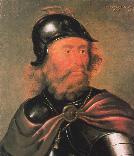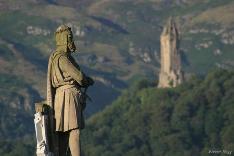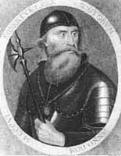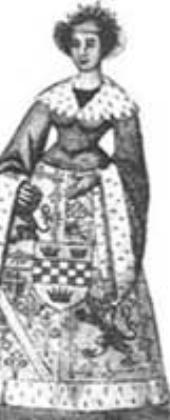Christina ( - )
1. Christina de Ireby married Robert de Brus.
Lord Robert de Brus, son of Robert de Brus, 5th Lord Annandale ( - ) and Isabella de Clare (1226-1264), was born in 1210. He had the title 'Lord of Annandale'. He died on [Julian] 31 March 1295. He and Christina de Ireby had the following children:
| +2 |
Second Generation
2. Robert le Brus, son of Lord Robert de Brus and Christina de Ireby, was born in [Julian] 1243. He had the title 'Earl of Carrick'. He had the title 'Earl of Carrick, 6th Lord Annandale'. He died before [Julian] 4 April 1304. He married Marjorie COUNTESS OF CARRICK.
He was also known as Robert Bruce. Through his marriage, Robert le Brus, Earl of Carrick gained the title of Earl of Carrick in 1271. He abdicated as Earl of Carrick on 27 October 1292. He succeeded to the title of Lord of Annandale before 4 July 1295. Amongst his ten children were the King of Scots, King of Ireland and Queen of Norway.
Robert de Brus or Robert Bruce whom some genealogists name "Robert VI de Brus" (c 1250 - c 1304), 6th Lord of Annandale, Earl of Carrick jure uxoris was a feudal lord in Scotland and England during prelude stages of Wars of Scottish Independence. He descended from royal lineage that would give his family a claim to the Crown of Scotland.
He was the son and heir of Robert de Brus, 5th Lord of Annandale, who then in 1290 claimed the succession to the Throne of Scotland, being one of the two main competitors to rival it. (In 1306, after his death, his eldest son Robert the Bruce eventually succeeded in becoming the king.)
There is an ongoing debate as to whether Robert or his son were born on the family estate in Writtle Essex. The current Dictionary of National Biography indicate the father rather than the contemporary account that Robert I were possibly born in Writtle.
Legends tell that Robert de Brus, heir to Lord of Annandale, was a handsome young man when participating in the Eighth Crusade. Adam de Kilconcath, one of his companion-in-arms, fell in 1270 in Holy Land, and Robert obliged to travel to tell the sad news to Adam's widow Marjorie of Carrick (1256-1292). Story continues reporting that Marjorie was so taken with the messenger that she had him held captive till he agreed to marry her in 1271.
The contemporary records seem to suggest Robert's father accompanied the Princes Edward and Edmund on the 1270-4 crusade, in lieu of his sons.
His wife was by all accounts a formidable woman. Marjorie was the daughter of Niall, 2nd Earl of Carrick, and his heiress. Carrick was a Gaelic Earldom in Southern Scotland. Its territories contained much of today Ayrshire and Dumfriesshire. The couple held at least Turnberry Castle and Lochmaben. Marriage with Marjorie made Robert the Earl, as was the custom of that time.
Their children were:
Robert the Bruce
Edward Bruce
Thomas Bruce, executed 1307
Alexander Bruce, executed 1307
Neil Bruce (Niall or Nigel), executed 1306
Christina Bruce (Christian), married Gartnait, Earl of Mar, mother of Domhnall II, Earl of Mar
Mary Bruce, married (1) Neil Campbell; (2) Alexander Fraser
Isobel Bruce (Isabel), married King Eric II of Norway
Matilda Bruce, married Aodh, Earl of Ross
Countess Marjorie died in 1292, and on the day of his wife's death Robert transferred Carrick to their eldest son, the future Robert I of Scotland thus making the son the Earl of Carrick.
Undoubtedly the biggest event of his life was the 'Great Cause' that was concluded in 1292. It gave the Crown of Scotland to his family' great rival, Balliol, instead of his father. Heiress Margaret, the Maid of Norway had died on the Orkney Islands around September 26, 1290. With her death, the main line of the House of Dunkeld came to an end and thirteen competitors claimed their rights to the Scottish crown. The two main competitors were Robert de Brus, 5th Lord of Annandale (Robert's own father) and John Balliol, Lord of Galloway. Fearing civil war between the Bruce and Balliol families and their supporters, the Guardians of Scotland asked the kingdom's southern neighbor, Edward I of England to arbitrate among the claimants in order to avoid civil war.
Arbitration processed slowly. After initial solutions which left two contenders, on August 3, 1291 Edward asked both de Balliol and de Brus to choose forty arbiters while he himself chose twenty-four, to decide the case. The arbiters finally gave judgement in early November in favour of John Balliol, in accordance with the precedents of primogeniture: even twenty-nine of Bruce's own auditors voted for Balliol, underlining the strength of his claim. On 17 November Edward gave formal judgement in open court; and on November 30, John Balliol was crowned as King of Scots at Scone Abbey. On December 26, at Newcastle upon Tyne, King John swore homage to Edward I for the kingdom of Scotland. Edward soon made it clear that he regarded the country as his vassal state. The Bruce family thus lost what they regarded as their rightful place on the Scottish throne.
Soon afterwards, his father, Robert de Brus, 5th Lord of Annandale - the unsuccessful claimant - resigned his lordship to him. And also his claim to crown, in order to prevent it from extinguishing.
Both Robert and his son the new Earl of Carrick sided with Edward I against Balliol. In April 1294, Robert's son had permission to visit Ireland for a year and a half and, as a further mark of Edward's favour, he received a respite for all the debts owed by him to the English Exchequer. In 1295, his son and heir married his first wife, Isabella of Mar, the daughter of Donald, 6th Earl of Mar. Isabella died a year later bearing child, Marjorie Bruce, Robert's granddaughter.
It was not until 1295 that Edward I was even aware of the secret Franco-Scottish negotiations. In early October, Edward began to strengthen his northern defences against a possible invasion by a revitalised Scottish army. It was also at this point that Robert Bruce himself was appointed governor of Carlisle Castle. Edward also ordered John Balliol to relinquish control of the castles and burghs of Berwick, Jedburgh and Roxburgh. In December, more than two hundred of Edward's tenants in Newcastle were summoned to form a militia by March 1296 and in February, a fleet of ships sailed north to rendezvous with his land forces in Newcastle.
The build up of English forces south of the Anglo-Scottish border did not go undetected and in response, King John Balliol summoned all able-bodied Scotsmen to bear arms and converge near the border at Caddonlee by March 11.
Balliol seized Robert's Annandale estate and reassigned it to John 'The Red' Comyn, Lord of Badenoch. Several of the Scottish nobles choose to ignore the summons, including his son Robert de Brus, Earl of Carrick.
The beginning of the Wars of Independence: In August 1296 Robert and his son swore fealty to Edward I at Berwick, but in breach of this oath, which had been renewed at Carlisle, the younger Robert joined in the Scottish revolt against Edward in the following year.
Shortly after the Battle of Stirling Bridge, Annandale was wasted as retaliation to younger Bruce's actions. Yet, when Edward returned to England after his victory at the Battle of Falkirk, Annandale and Carrick were excepted from the lordships and lands which he assigned to his followers, father having not opposed Edward and the son being treated as a waverer whose allegiance might still be retained.
In July, Edward I launched his sixth campaign into Scotland. Though Edward captured Bothwell and Turnberry Castle, Edward did little to damage the Scots’ fighting ability and, in January 1302 agreed to a nine-month truce.
Robert at that time was old and ill, and there are reports that he wished his son to seek peace with Edward, who, he was convinced, would be victorious over the Scots. The elder Bruce would have seen that, if the rebellion failed and his son were against Edward, the son would lose everything, titles, lands, and probably his life.
It was around this time that Robert's son submitted to Edward I, along with other nobles, even though he had been on the side of the patriots until now. There are many reasons which may have prompted his turning, not the least of which was that the Bruce family may have found it loathsome to continue sacrificing his followers, family and inheritance for John Balliol. There were rumours that Balliol would return with a French army and regain the Scottish throne. Soulis supported the return of Balliol as did many other nobles, but the return of John as king would lead to the Bruces losing any chance of ever gaining the throne themselves.
When old, this Robert Bruce, 6th Lord of Annandale, suffered from a skin ailment, what some contemporary accounts mention as leprosy. Tendency to severe skin disease apparently was hereditary in Bruce line, as a similar tale of illness is traditionally attached to late years of his son as well.
Robert spent the last few years of his life in retirement on his estates in Cumberland, before dying and being buried in Holmecultram in 1304.
He was portrayed by Ian Bannen in the 1995 film Braveheart.
Countess Marjorie COUNTESS OF CARRICK, daughter of Niall, Earl of CARRICK (bef1234-c. 1256) and Margaret STEWART (bef1235- ), was born before 1250. She had the title 'Countess of Carrick'. She died before [Julian] 9 November 1292. She and Robert le Brus had the following children:
| +3 |
Third Generation
3. Robert I Bruce KING OF SCOTLAND, son of Robert le Brus and Countess Marjorie COUNTESS OF CARRICK, was born on [Julian] 11 July 1274 in Writtle, Chelmsford, Essex. He had the title 'King of Scotland'. He died on [Julian] 7 June 1329 in Cardross Castle, Cardross, Argyllshire. He married Isabella MAR.
Robert I Bruce, King of Scotland was the son of Robert le Brus, Earl of Carrick and Margaret of Carrick, Countess of Carrick. He was born on 11 July 1274 at Writtle, Chelmsford, Essex, England.1 He married, firstly, Isabella, Lady of Mar, daughter of Sir Donald, 6th Earl of Mar and Helen, circa 1295.1 He married, secondly, Lady Elizabeth de Burgh, daughter of Richard de Burgh, 2nd Earl of Ulster and Margaret de Burgh, in 1302.1 He died on 7 June 1329 at age 54 at Cardoss Castle, Cardross, Argyllshire, Scotland.2 He was buried at Dunfermline Abbey, Dunfermline, Fife, Scotland.2
He succeeded to the title of Earl of Carrick on 27 October 1292.3 He succeeded to the title of Lord of Annandale between 1295 and 1304.1 On 20 February 1305/6 he was attainted, and his English estates declared forfeit by King Edward I.1 He gained the title of King Robert I of Scotland on 25 March 1306.1 He was crowned King of Scotland on 27 March 1306 at Scone Abbey, Scone, Perthshire, Scotland.1 He fought in the Battle of Bannockburn on 24 June 1314 at Bannockburn, Scotland.
Isabella MAR, daughter of Sir Donald MAR (bef1252-aft1297) and Helen of Wales ( -aft1294), had the title 'Lady of Mar'. She appeared in the census. She died before 1302. She and Robert I Bruce KING OF SCOTLAND had the following children:
| 4 | Margorie Bruce PRINCESS OF SCOTLAND (c. 1297-1316). Margorie was born circa 1297. She had the title 'Princess of Scotland'. She died on [Julian] 2 March 1316. |



